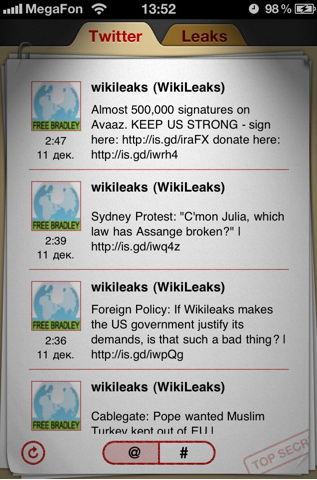
Update: Apple made an official statement about why the pulled the app and appears to put the donation policy out of the picture. So far, no official word from Apple on the iPhone app donation issue.
Today, the Guardian Technology blog speculated that the reason why the Wikileaks iPhone app was pulled from the iTunes store was because the $1.95 fee for the app was a donation to the organization.
Let’s unpack this ….
This is a nuanced issue. No doubt about it. The online petition with over 8000 signatures asks Mr. Jobs to make it easier for legitimate nonprofits to accept donations in one-click via their credit card on file with the iTunes store. So far, no official response from Apple despite all these articles and blog posts about the issue, including this one from the New York Times.
Apple doesn’t want to do this. Their excuse is a cop out. Apple has a reasonable concern about liability and being sued. What if there are scams and the donations aren’t really getting to a verified nonprofit. That’s why they’re taking a hard line on their App Store Review Guidelines (see section 21 – by only allowing SMS or HTML donations) and preventing any in-app donations, altogether — whether it is donating through the app itself or paying the app fee as a donation to the nonprofit. It has been suggested that the hard line is really to protect its bottom line of a 30% cut on financial transactions and this has prompted criticism of Apple not being a good corporate citizen.
Let’s look at the vetting process Apple is using for nonprofits using the pulling of the Wikileaks App as an example. Apple identifies a problem with the organization, kicks them (or their app) out of the store. So in the case of a high profile story like Wikileaks and donations, Apple doesn’t need to do a lot of due diligence. But working with a subject-matter expert in nonprofit vetting, Apple improves the odds of catching any less well-known scofflaw charities or potential fundraising scams. Net result: a more trustworthy experience for donors and Apple reduces its liability.
Are there subject-matter experts in nonprofit vetting out there? Last week, Guidestar’s CEO posted this invitation to Apple on his blog.
People want a way to help the causes they care about, and they want to be able to do it easily via their mobile devices. Apple is a leading platform of mobile apps. GuideStar is the premier source of vetting nonprofit information. I think this could be the beginning of a beautiful friendship.
In addition, there are others who have vetting systems for technology companies such as TechSoup Global.
Yes, there are nonprofits using the HTML app and SMS donation workarounds as there are other nonprofits using the app fee for donation approach. As nonprofits explore the best practices for an integrated mobile fundraising strategy over the coming years and as my nonprofit technology colleagues Peter Campbell, Steve MacLaughlin, and Michelle Murrain point out it isn’t all about iPhone apps, it is about an overall mobile strategy as well as not shutting nonprofits out of a closed system.
Meanwhile, with my Nexus S and Windows 7 phones in hand, I’m exploring what the opportunities are for nonprofit apps and charitable giving apps — Apps for Caring …on these platforms.

Leave a Reply